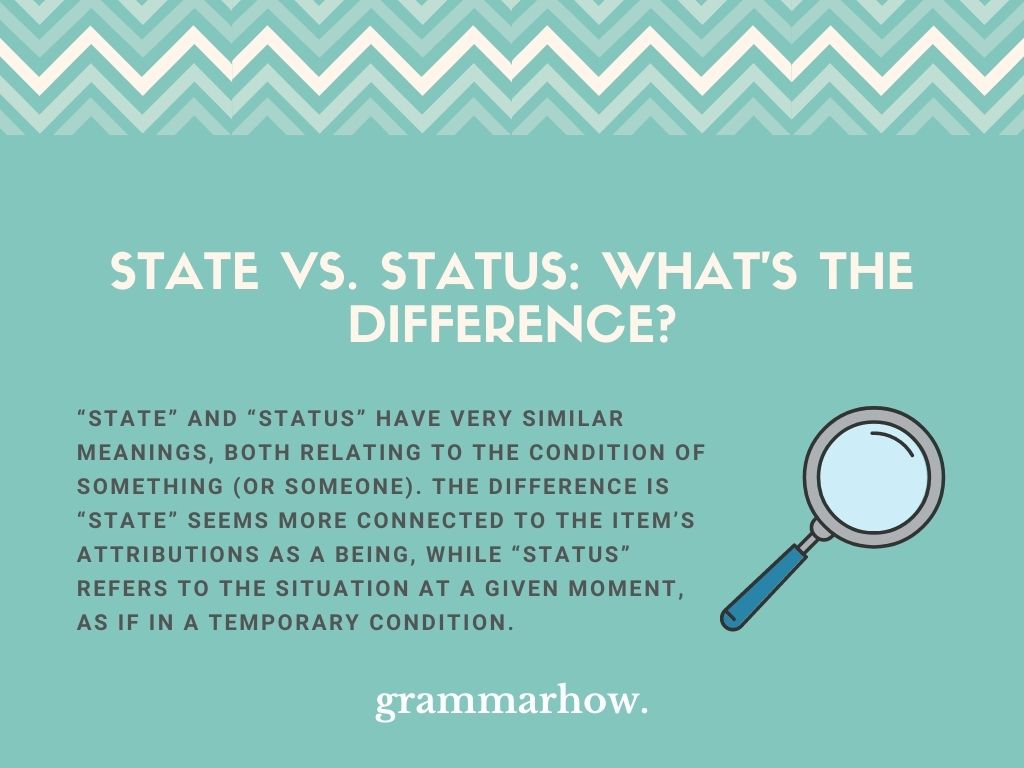Do the words “State” and “Status” mean the same thing? Sometimes, when words seem similar and we wonder if they’re synonyms, the best thing to do is look into each separately.
By doing that, we can understand the differences, and make sure we’re using both words in the correct way.
State vs. Status: What’s the Difference?
“State” and “Status” have very similar meanings, both relating to the condition of something (or someone). The difference is “State” seems more connected to the item’s attributions as a being, while “Status” refers to the situation at a given moment, as if in a temporary condition.

Let’s look at some examples:
- What is the status of the company’s project?
- What is the state of the company’s project?
- The type of treatment will depend on the patient’s health status.
- The building is in a state of disrepair.
A patient’s health “Status” is usually transitory, and may change. It also doesn’t relate to who they are as people. The health “Status” indicates a temporary condition that will allow (or not) for certain types of treatment to be used.
On the other hand, a building is in a “State” of disrepair. Such a situation isn’t transitory and is hard to change: a lot of work, time and money would have to be put in the building to change its “State”.
State
State describes the condition in which a person, or a thing is, in general. A “State” may change, of course, but It relates to a position that is not easy to change. A subject’s “State” at a certain time reflects what it is and how it exists.
In The Cambridge Dictionary we find the following definition: “a condition or way of being that exists at a particular time”, reinforcing the idea that a “State” is attached to what something is, its existence.
“State”, when used correctly, will work as in the sentences below:
- The room was in a state of disarray.
- The phone was in such a bad state that it wasn’t worth repairing.
- Substances can be in various states, such as liquid, gas, or solid.
- Terry was in a horrible state.
- He was in a state of depression.
Obviously, most “States” can be changed. However, it implies a certain difficulty or that some effort would be needed for it to happen.
Status
“Status” reflects the situation for the present time. It’s not connected so much to an individual’s “State” of being as it’s to its momentary circumstance. “Status” is one dimensional, and doesn’t necessarily relate to the overall “State” of the subject.
In fact, The Cambridge Dictionary defines “Status” as “the situation at the present time”. It indicates a transitory condition.
Here are some examples of “Status” being used in a sentence:
- Gerald was enjoying his new status as CEO.
- Robert was not pleased with the status of the research.
- Jill’s financial status didn’t allow for the purchase of a house.
- Your order status has changed to “Shipped”.
- After the ordeal, Andrew’s relationship status changed.
“Status” often indicates a position that might be temporary, transitory or limited, such a CEO “Status”.
The word “Status” doesn’t define a being’s overall situation (like “State” would). When we say a relationship’s “Status” has changed, we’re discussing a single dimension of the situation, not the whole.
In other words, even though Andrew’s relationship “Status” has changed, he might remain in a “State” of peace and happiness.
Which Is Used the Most?
What do you think is a topic of conversation more often: “State” or “Status”? Let’s see by taking a look at the graph from Google Ngram Viewer below.

“State” has always been more used that “Status”, as we can see by the graph. However, it’s interesting to notice that the usage for “State” has decreased greatly, especially after the year 2000.
Project State vs. Project Status
“Project State” indicates the overall condition of a project as whole. It provides a holistic view of the project. “Project Status” relates to the current momentary condition, the situation on the step that is being taken at the project at a certain point in time.
- The project was in a state of complete success at that time.
- The project is in a state of disarray, we must take action.
- The project is currently in phase 3. That’s the status.
- The research status is changing, as we move to the trial phase.
You may also like: Statuses vs status? Here’s the plural of status with 5 examples

Martin holds a Master’s degree in Finance and International Business. He has six years of experience in professional communication with clients, executives, and colleagues. Furthermore, he has teaching experience from Aarhus University. Martin has been featured as an expert in communication and teaching on Forbes and Shopify. Read more about Martin here.
